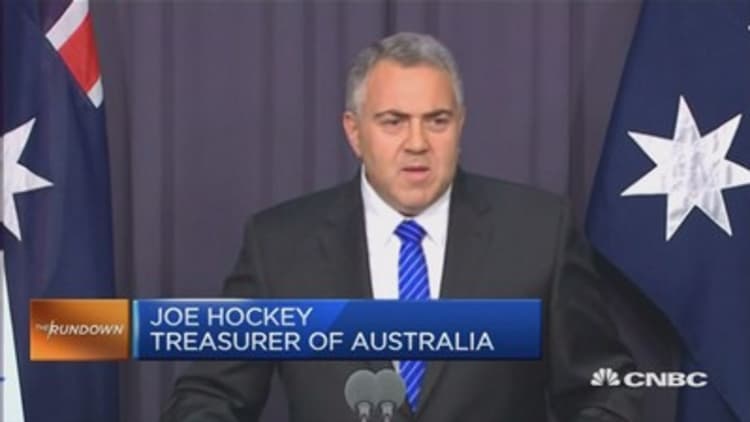
As Australia grapples with a slowing resources sector exacerbated by plummeting commodity prices, analysts say the Australian budget due Tuesday will be about propping up sub-par economic growth rather than the traditional fiscal discipline.
Iron ore pain
Falling commodity prices and slowing income growth are expected to strip off 21 billion ($16.6 billion) Australian dollars from revenues, according to a May 6 Goldman Sachs report.
Iron ore is such a central part of the Australian government's revenue that "the key revision to economic parameters is likely to be a downward revision to iron ore prices and the terms of trade," ANZ said in its May 4 budget preview report.
Treasurer Joe Hockey recently suggested the government's forecast for iron ore prices may be slashed to $35 a metric ton from $60 per metric ton, according to the ANZ note. Iron ore futures were quoted at $62.50 on Tuesday.
Fiscal repair shelved
Revenues may be falling but voters don't like spending cuts, and as a result, the government will be forced to shelve any plans to get any closer to balancing the budget.
"The focus will change, and fiscal reform will become a medium term goal – the priority will be helping the economy to grow," ANZ senior economist Jo Masters told CNBC by phone.
ANZ sees the budget deficit narrowing to 0.8 percent of gross domestic product (GDP) by 2017-2018.
"No political party could be realistically expected to stem the hemorrhaging in tax revenue that occurs in sharply falling terms of trade and the corresponding weak nominal growth environment," said Goldman in the note.
Deficit will narrow, a bit
The deficit will narrow this year from last year, but not at the rates forecast by the government.
The government is forecasting a deficit of 1.9 percent in 2015-16, according to the last mid-year economic and fiscal outlook published last December.
ANZ expects the underlying cash deficit to fall to 2.3 percent of GDP in 2015-2016, from 2.6 percent in 2014-2015.
Goldman expects the cash deficit in 2015-16 to come in at 2.5 percent of GDP, down from 2.9 percent in 2014-2015.
Learning last year's lessons
Many of last year's most unpopular measures, such as cuts to higher education loans, were blocked by the Senate; while others, such as welfare cuts, have yet to be passed by in the upper house.
The risk is "another year of policies stuck in the Senate in the midst of sub-par growth," said ANZ's Masters.
Selling the budget
Last year's proposed spending cuts were so unpopular that Prime Minister Tony Abbot will be under pressure to convince voters that they have something to gain in this year's budget.
"Selling the budget [to the public] is critical," ANZ's Masters said, although she conceded that "it's difficult to see what would lift business and consumer confidence at this stage."
Business confidence remained flat at subdued levels in April, according to National Australia Bank's business survey, while ANZ's consumer confidence fell to an eight-month low in the first week of May.

